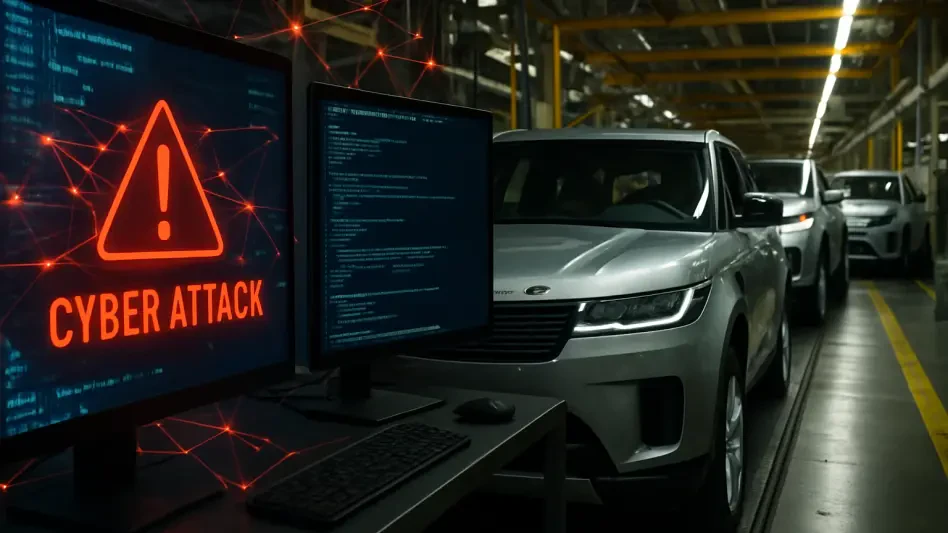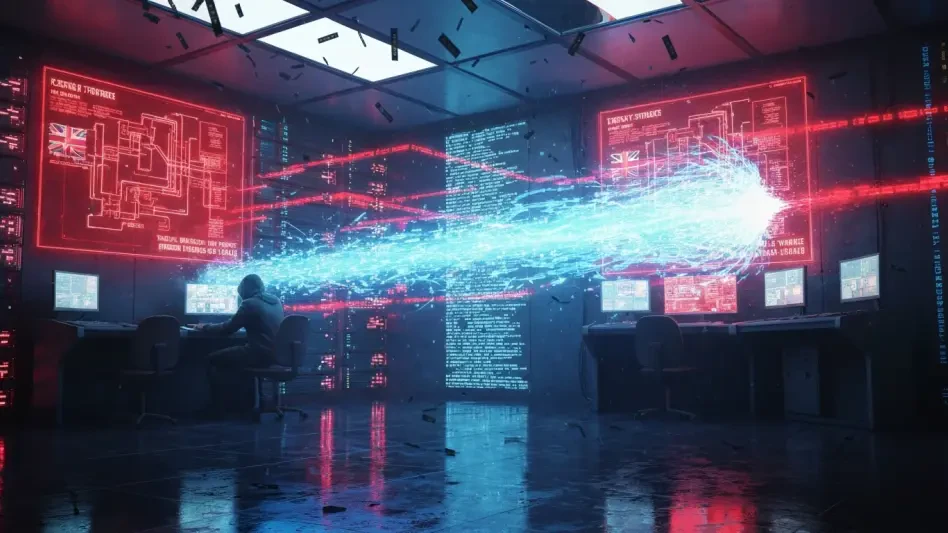In a world increasingly reliant on digital systems, the automotive industry faces unprecedented risks, as evidenced by a crippling cyberattack on Jaguar Land Rover (JLR) that struck on August 31, forcing a shutdown of its global production. This devastating breach, attributed to the group Scattered Lapsus$ Hunters, exposed the fragility of modern industrial networks and compelled one of the sector’s leading manufacturers to take its systems offline by September 2, impacting major facilities across the UK, Slovakia, China, and India, with production halted until at least September 24. The incident not only disrupted the flow of vehicles during a critical sales period but also sent shockwaves through the supply chain, highlighting the interconnected nature of today’s manufacturing landscape. As JLR grapples with restoring operations and investigating the breach, this event raises urgent questions about cybersecurity in an era of rapid digital transformation, setting the stage for a deeper examination of the attack’s impact and implications.
Unraveling the Disruption
Scope and Severity of the Breach
The scale of the cyberattack on JLR became apparent almost immediately after the breach on August 31, when the company was compelled to shut down its global systems just two days later. Affecting key production hubs in the UK—such as Halewood, Solihull, Wolverhampton, and Castle Bromwich—as well as facilities in Slovakia, China, and India, the attack paralyzed operations across multiple continents. The group behind this disruption, Scattered Lapsus$ Hunters, is known for targeting high-profile entities and reportedly infiltrated JLR’s internal SAP systems, deploying ransomware to lock critical operations. While no customer data breaches have been confirmed, the severity of the incident lies in its ability to halt production entirely, leaving the company in a race against time to restore functionality. This breach underscores how a single point of failure in digital infrastructure can cascade into a global crisis, exposing vulnerabilities that even major corporations struggle to anticipate or mitigate effectively in real-time.
Beyond the immediate shutdown, the complexity of the attack has prolonged JLR’s recovery efforts, with production expected to remain stalled until at least September 24. The forensic investigation into the ransomware deployment and system compromise requires meticulous attention to ensure no lingering threats remain. Scattered Lapsus$ Hunters’ history of targeting retailers suggests a sophisticated approach, likely exploiting specific weaknesses in JLR’s digital defenses. The focus on SAP systems, which are integral to managing enterprise resources, indicates a targeted effort to disrupt core operational functions. This incident reveals the high stakes of cybersecurity in manufacturing, where a breach is not just a technical issue but a direct threat to physical production lines. The global scope of the impact also highlights the challenge of coordinating a unified response across diverse regions, each with its own regulatory and operational constraints, further complicating JLR’s path to normalcy.
Operational Ripple Effects
The operational consequences of the cyberattack have reverberated far beyond JLR’s factory walls, disrupting the delicate balance of the automotive ecosystem. With production halted at major facilities, the flow of new vehicles ground to a standstill during the critical September registration period, a peak time for sales in many markets. Dealerships, reliant on steady deliveries, now face significant delays, eroding customer confidence and straining business relationships. This timing could not have been worse, as the registration period often drives substantial revenue through bulk orders and fleet sales. The inability to meet demand during this window risks long-term reputational damage, as competitors may seize the opportunity to fill the gap. The standstill paints a stark picture of how digital disruptions can translate into tangible, real-world losses for a company of JLR’s stature, affecting every link in the distribution chain.
Equally concerning is the cascading impact on JLR’s supply chain, which has been brought to a near halt by the attack. Suppliers, unable to access production schedules or dispatch critical parts, find themselves in limbo, with their own operations disrupted by the lack of communication and coordination. This interconnected web of dependencies illustrates a broader vulnerability within the industry, where a single company’s downtime can stall an entire network of partners. The ripple effect extends to smaller vendors who may lack the resources to weather such disruptions, potentially leading to financial strain or layoffs. For JLR, managing these relationships while restoring internal systems adds another layer of complexity to an already daunting recovery process. The incident serves as a reminder that in the age of globalized manufacturing, operational resilience must account for both internal and external dependencies to prevent widespread fallout from digital threats.
Economic and Strategic Challenges
Economic Consequences
Financially, the cyberattack has dealt a severe blow to JLR at a time when the company was already navigating turbulent waters. The estimated revenue loss from the production halt stands at a staggering $1 billion, a figure that compounds the pain of a reported halving of profits in the second quarter due to punitive US tariffs on vehicles and parts. These tariffs, set at 27.5%, have already squeezed margins, making the timing of this disruption particularly devastating. The loss of output during the September sales window further exacerbates the economic damage, as missed opportunities in a key market period are unlikely to be fully recouped. This financial hit threatens to undermine investor confidence and could force JLR to reassess its budgetary priorities, potentially delaying planned investments or expansion initiatives. The scale of the loss highlights how cyber incidents can amplify existing economic pressures, creating a perfect storm for even the most established manufacturers.
While the financial outlook appears grim in the short term, there are glimmers of potential relief on the horizon for JLR. A recent UK-US trade agreement offers hope for easing the burden of tariffs, which could provide some breathing room for recovery efforts. However, the immediate focus remains on mitigating the $1 billion shortfall caused by the attack, a sum that reflects not just lost production but also the costs of system restoration and forensic analysis. The broader economic context, including fluctuating global demand and rising operational costs, adds urgency to stabilizing operations swiftly. For JLR, the challenge lies in balancing the need to address this acute crisis with longer-term strategies to rebuild financial resilience. This incident underscores the reality that in today’s volatile market, cybersecurity failures can have outsized economic consequences, pushing companies to rethink how they allocate resources to prevent future disruptions of this magnitude.
Digital Transformation and Vulnerabilities
JLR’s ongoing digital transformation, aligned with Industry 4.0 principles, was intended to modernize operations but has instead exposed critical vulnerabilities through this cyberattack. Under the leadership of figures like Paulina Chmielarz, the company has prioritized integrating supply chain, procurement, and manufacturing data to enhance visibility and efficiency. Efforts to improve end-to-end tracking of the bill of materials have aimed to streamline processes and boost cross-functional collaboration. However, the attack reveals the inherent risks of such connectivity, where a single breach can compromise an entire network of systems. The push for smarter, data-driven operations, while innovative, has inadvertently widened the attack surface for cybercriminals seeking to exploit digital dependencies. This incident highlights a painful trade-off between technological advancement and security, forcing a reevaluation of how such transformations are implemented in high-stakes industries.
Industry voices, such as Simon Inskip, have long warned of the risks tied to compliance, climate challenges, and emerging technologies like electric vehicles, all of which demand robust risk-sensing platforms. The cyberattack on JLR serves as a stark validation of these concerns, demonstrating that even proactive modernization efforts can falter without ironclad cybersecurity measures. The reliance on connected systems for efficiency often outpaces the development of adequate defenses, leaving gaps that groups like Scattered Lapsus$ Hunters can exploit. High-quality data inputs and real-time risk detection, though prioritized in theory, proved insufficient in this case, exposing weaknesses in JLR’s digital armor. The broader lesson for the sector is clear: digital transformation must be paired with equally aggressive investments in security infrastructure. Without this balance, the benefits of Industry 4.0 risk being overshadowed by the potential for catastrophic disruptions like the one JLR now faces.
Industry-Wide Implications
Manufacturing Under Fire
The cyberattack on JLR is not an isolated event but a symptom of a larger crisis facing the manufacturing sector, which has become a prime target for digital threats. According to IBM’s latest Threat Index Report, manufacturing has been the most attacked industry over the past four years, with ransomware and extortion accounting for 29% of incidents and data theft making up 24%. These attacks often exploit outdated legacy systems that many companies still rely on, systems ill-equipped to counter modern threats. The financial and intellectual property value within the sector makes it an attractive mark for cybercriminals, who can disrupt operations or demand hefty ransoms. JLR’s experience mirrors this trend, serving as a high-profile example of how pervasive and damaging these threats have become. The industry’s challenge lies in modernizing infrastructure while under constant siege, a task that requires both technological upgrades and a cultural shift toward prioritizing cybersecurity.
Compounding the issue is the emergence of generative AI as a tool for cybercriminals, enabling them to scale attacks with unprecedented speed and efficiency. The same report from IBM warns that AI-driven tactics lower the barrier for attackers, allowing even less-skilled groups to orchestrate sophisticated campaigns. For manufacturing firms, many of which operate on tight margins, investing in cutting-edge defenses against such evolving threats often competes with other operational priorities. The result is a persistent vulnerability, as seen in JLR’s case, where even a company pursuing digital innovation fell victim to ransomware. This growing menace underscores the urgency for the sector to adopt proactive measures, from regular system audits to employee training on phishing and other entry points for attacks. The stakes are higher than ever, as each incident not only disrupts individual companies but also erodes trust in the reliability of global supply chains.
Lessons for a Connected Future
Reflecting on the JLR cyberattack, it becomes evident that the incident was a critical turning point for both the company and the broader industry, exposing the fragility of connected systems. The breach by Scattered Lapsus$ Hunters was a sobering reminder that digital transformation, while essential, carries significant risks if not fortified by robust security protocols. Manufacturing leaders must confront the reality that their sector’s reliance on legacy technology and interconnected operations makes it a perennial target for increasingly sophisticated attackers. The financial toll, estimated at $1 billion, and the operational standstill across multiple continents are stark indicators of the potential consequences when defenses fail. This event is not just a setback for JLR but a cautionary tale for all manufacturers navigating the complexities of Industry 4.0.
Looking ahead, the path forward demands a renewed focus on integrating cybersecurity into the core of digital strategies. Companies need to invest in advanced risk detection, regularly update legacy systems, and foster a culture of vigilance to counter threats like ransomware and AI-amplified attacks. Collaboration across the industry can also play a pivotal role, with shared intelligence on emerging threats helping to build collective resilience. For JLR, rebuilding trust with suppliers and customers requires transparent communication and tangible improvements in system security. Beyond individual efforts, policymakers and tech providers have a role in developing frameworks and tools to protect critical infrastructure. The lesson from this disruption is clear: safeguarding the future of manufacturing means treating cybersecurity not as an afterthought but as a fundamental pillar of innovation and operational stability.








